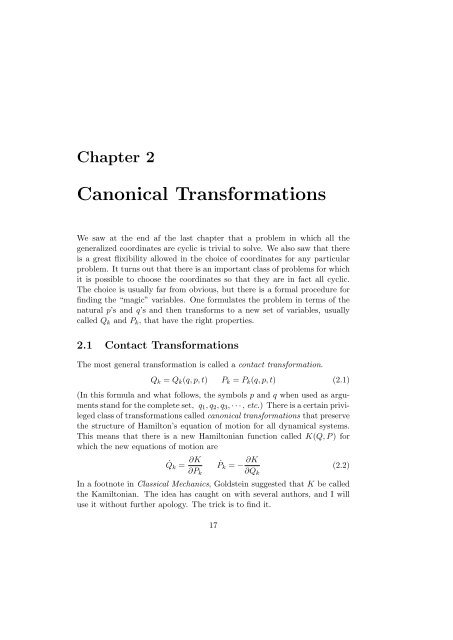Nonlinear Mechanics - Physics at Oregon State University
Nonlinear Mechanics - Physics at Oregon State University
Nonlinear Mechanics - Physics at Oregon State University
You also want an ePaper? Increase the reach of your titles
YUMPU automatically turns print PDFs into web optimized ePapers that Google loves.
Chapter 2<br />
Canonical Transform<strong>at</strong>ions<br />
We saw <strong>at</strong> the end af the last chapter th<strong>at</strong> a problem in which all the<br />
generalized coordin<strong>at</strong>es are cyclic is trivial to solve. We also saw th<strong>at</strong> there<br />
is a gre<strong>at</strong> flixibility allowed in the choice of coordin<strong>at</strong>es for any particular<br />
problem. It turns out th<strong>at</strong> there is an important class of problems for which<br />
it is possible to choose the coordin<strong>at</strong>es so th<strong>at</strong> they are in fact all cyclic.<br />
The choice is usually far from obvious, but there is a formal procedure for<br />
finding the “magic” variables. One formul<strong>at</strong>es the problem in terms of the<br />
n<strong>at</strong>ural p’s and q’s and then transforms to a new set of variables, usually<br />
called Qk and Pk, th<strong>at</strong> have the right properties.<br />
2.1 Contact Transform<strong>at</strong>ions<br />
The most general transform<strong>at</strong>ion is called a contact transform<strong>at</strong>ion.<br />
Qk = Qk(q, p, t) Pk = Pk(q, p, t) (2.1)<br />
(In this formula and wh<strong>at</strong> follows, the symbols p and q when used as arguments<br />
stand for the complete set, q1, q2, q3, · · · , etc.) There is a certain privileged<br />
class of transform<strong>at</strong>ions called canonical transform<strong>at</strong>ions th<strong>at</strong> preserve<br />
the structure of Hamilton’s equ<strong>at</strong>ion of motion for all dynamical systems.<br />
This means th<strong>at</strong> there is a new Hamiltonian function called K(Q, P ) for<br />
which the new equ<strong>at</strong>ions of motion are<br />
˙Qk = ∂K<br />
∂Pk<br />
Pk<br />
˙ = − ∂K<br />
∂Qk<br />
(2.2)<br />
In a footnote in Classical <strong>Mechanics</strong>, Goldstein suggested th<strong>at</strong> K be called<br />
the Kamiltonian. The idea has caught on with several authors, and I will<br />
use it without further apology. The trick is to find it.<br />
17
















